Analytical Solutions for the Equal Width Equations Containing Generalized Fractional Derivative Using the Efficient Combined Method
Abstract
In this paper, the efficient combined method based on the homotopy perturbation Sadik transform method (HPSTM) is applied to solve the physical and functional equations containing the Caputo–Prabhakar fractional derivative. The mathematical model of this equation of order μ ∈ (0,1] with λ ∈ ℤ+, θ, σ ∈ ℝ+ is presented as follows: where for λ = 1, θ = 1, σ = 1s and λ = 2, θ = 3, σ = 1, equations are changed into the equal width and modified equal width equations, respectively. The analytical method which we have used for solving this equation is based on a combination of the homotopy perturbation method and Sadik transform. The convergence and error analysis are discussed in this article. Plots of the analytical results with three examples are presented to show the applicability of this numerical method. Comparison between the obtained absolute errors by the suggested method and other methods is demonstrated.
1. Introduction
- (1)
If λ = 1, θ = 1, σ = 1 are considered, then equation (1) becomes the nonlinear equal width equation of fractional order μ. This type of equation is one of the most important equations that examine the nonlinear behaviors of physical phenomena such as hydromagnetic waves [21], optics [22], and biological systems [23].
- (2)
If λ = 2, θ = 3, σ = 1 are considered, then equation (1) becomes the nonlinear modified equal width equation (MEW) of fractional order μ.
The main reason for choosing the three-parameter Mittag-Leffler function in this paper is related to its application in many models such as disordered materials and heterogeneous models [34], Havriliak–Negami models [35, 36], viscoelasticity models [37], stochastic models [38], probability models [39], spherical stellar models [40], Poisson models [41], and fractional models or integral models [42–45]. Many research studies have been conducted in numerical fields to obtain numerical solutions of fractional differential equations such as the Adomian decomposition method [46], the q-homotopy analysis transform method (q-HATM) [47], the Laplace transform method [48], the method based on the implementation of an iterative perturbation method [49], the numerical method based on the Petrov–Galerkin method [50], the Petrov–Galerkin finite element scheme [51], the local discontinuous Galerkin method [52], and other methods [24, 27, 30, 53]. Recently, a new integral transform named the Sadik transform was introduced by Sadikali Latif Shaikh in 2018 (see [54, 55]). The Sadik transform is nothing but an unification of the Laplace transform, Sumudu transform, Elzaki transform, and all those integral transforms whose kernels are of exponential type or similar to the kernel of the Laplace transform. The Sadik transform is a very powerful integral transform. In this paper, we apply the HPSTM to solve the nonlinear time-fractional EW equation, MEW equation, and VMEW equation. The key intention of the present work is to extend the utilization of the HPSTM to derive analytical and approximate solutions of the time-fractional EW equation, time-fractional MEW equation, and time-fractional VMEW equation.
This paper is organized as follows. Some definitions and mathematical preliminaries of the fractional calculus are presented in Section 2. In Section 3, we introduce an analytical method based on the HPSTM to the nonlinear nonhomogeneous partial differential equation. In Section 4, to show the validity of the suggested method in Section 3, three examples are simulated.
2. Important Notations
In this section, we express theorems and lemmas which are used in the next parts.where ℜ(μ) > 0, ℜ(ρ) > 0 and ρ, μ, ω, γ ∈ ℂ.
Lemma 2 (see [3].)The following relation holds:
Lemma 3 (see [57].)Suppose Φ1(υ, α, β) is a Sadik transform of φ1(t) and Φ2(υ, α, β) is a Sadik transform of φ2(t). Then, Sadik transform of (φ1∗φ2)(t) is given by
Theorem 1 (see [57].)Suppose and φ(t), φ′(t), …, φm−1(t), m ∈ ℕ, are continuous. Then,
Theorem 2. The Sadik transform of the Caputo–Prabhakar fractional derivative of order μ for m = 1 is obtained by
3. The Proposed Scheme
Theorem 3. Let u(x, t) be the exact solution of equation (13) and un(x, t) be the approximate solution of equation (13) so that ‖un+1(x, t)‖ ≤ ϖ‖un(x, t)‖, ϖ ∈ (0,1), n ∈ ℕ. Then, the series defined by (20) converges.
Proof. From ‖un+1(x, t)‖ ≤ ϖ‖un(x, t)‖, we obtain
Then,
Therefore,
Because ϖ ∈ (0,1), ‖u − un‖⟶0 as n⟶∞. The proof is proven.
Theorem 4. Let u(x, t) be the exact solution of equation (1) and (u(x, t))N be the best approximate solution of equation (1) so that . Then, the following relation for the error holds:
Proof. Since u(x, t) is the exact solution of equation (1) and (u(x, t))N is the best approximate solution of equation (1), then we have
Using Lemma 2, equation (3), and , for , we get
By using the Lipschitz condition with constant 0 < k2 < 1 for derivative of the first order with respect to the variable x and theorem assumptions, from equation (25), we obtain
4. Numerical Results
4.1. Example 1
The comparison between the exact and the approximate solutions and the absolute error are expressed in Figure 1 for different values of μ when μ = 0.5, 0.85, 0.99, 1. Also, in Figure 2, the exact and the numerical solutions at t = 0.0001 are given. In Table 1, a comparison between the absolute error in [2] and the absolute error for HPSTM with different values of μ is given.
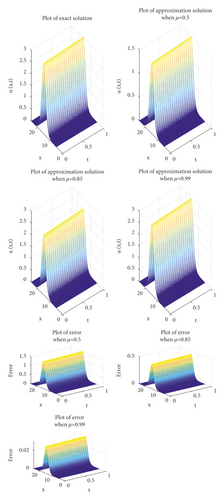
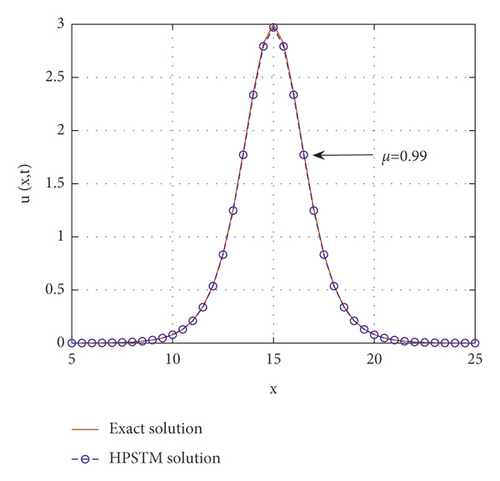
| x | |u − un| | |u − un| | ||
|---|---|---|---|---|
| μ = 0.5 | μ = 0.85 | μ = 0.99 | Method [2] | |
| 10 | 1.4006135487E − 09 | 1.4210717446E − 09 | 1.4412222851E − 09 | 7.242560880E − 06 |
| 11 | 1.4804436993E − 09 | 1.4994344786E − 09 | 1.5179577058E − 09 | 1.610108943E − 05 |
| 12 | 1.5534369379E − 09 | 1.5703105528E − 09 | 1.5865522230E − 09 | 2.246615682E − 05 |
| 13 | 1.16169787676E − 09 | 1.6310851118E − 09 | 1.6444028957E − 09 | 2.494373852E − 05 |
| 14 | 1.16685291313E − 09 | 1.6792699469E − 09 | 1.6890873673E − 09 | 1.482055499E − 04 |
| 15 | 1.17271757893E − 09 | 1.7298751108E − 09 | 1.7314989455E − 09 | 7.000000000E − 09 |
| 16 | 1.7315032733E − 09 | 1.7298837530E − 09 | 1.7271887190E − 09 | 1.482115835E − 04 |
| 17 | 1.7186088774E − 09 | 1.7127505267E − 09 | 1.7058693781E − 09 | 2.493848058E − 05 |
| 18 | 1.16891247436E − 09 | 1.6793110759E − 09 | 1.6685738938E − 09 | 2.247007139E − 05 |
| 19 | 1.6444545342E − 09 | 1.6311399784E − 09 | 1.6170367143E − 09 | 1.610299997E − 05 |
| 20 | 1.5866158664E − 09 | 1.5703768054E − 09 | 1.5535056371E − 09 | 7.243321962E − 06 |
4.2. Example 2
The comparison between exact solution and the approximate solution and absolute error are expressed in Figure 3 for different values of μ when μ = 0.5, 0.85, 0.99, 1. Figure 4 shows the comparison of exact solution with homotopy perturbation Sadik transform method solution at t = 0.0001. In Table 2, a comparison between the absolute error in [2] and the absolute error for HPSTM with different values of μ is given.
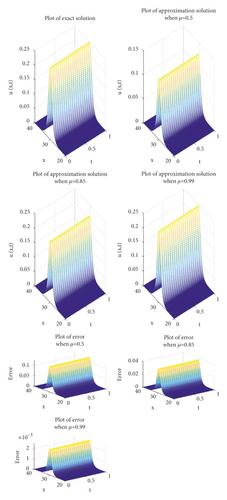
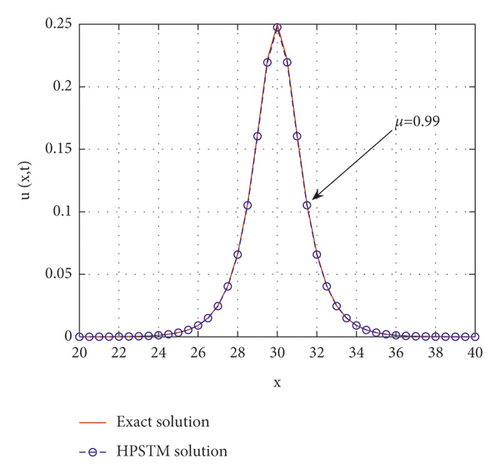
| x | |u − un| | |u − un| | ||
|---|---|---|---|---|
| μ = 0.5 | μ = 0.85 | μ = 0.99 | Method [2] | |
| 25 | 4.9233966126E − 09 | 4.8905216623E − 09 | 4.8523133049E − 09 | 8.419085488E − 07 |
| 26 | 4.7611171679E − 09 | 4.7088017083E − 09 | 4.6524848045E − 09 | 2.284567360E − 06 |
| 27 | 4.5293288600E − 09 | 4.4632329663E − 09 | 4.3946122324E − 09 | 6.130812328E − 06 |
| 28 | 4.2511941226E − 09 | 4.1770584430E − 09 | 4.1017168885E − 09 | 1.516464963E − 05 |
| 29 | 3.9485345529E − 09 | 3.8712015990E − 09 | 3.7936781419E − 09 | 2.113002231E − 05 |
| 30 | 3.6388500689E − 09 | 3.5618921913E − 09 | 3.4854390699E − 09 | 7.800000000E − 09 |
| 31 | 3.3345479504E − 09 | 3.2603221763E − 09 | 3.1870278987E − 09 | 2.113176846E − 05 |
| 32 | 3.04351478950E − 09 | 2.9734094032E − 09 | 2.9044644353E − 09 | 1.516821359E − 05 |
| 33 | 2.7701849765E − 09 | 2.7048973756E − 09 | 2.6408655090E − 09 | 6.132358065E − 06 |
| 34 | 2.5166006751E − 09 | 2.4563726541E − 09 | 2.3974113232E − 09 | 2.285133776E − 06 |
| 35 | 2.2832615675E − 09 | 2.2280532855E − 09 | 2.1740726737E − 09 | 8.421208912E − 07 |
In the example 2, we study the solution of a variant of fractional modified equal width equation (VMEW) which is obtained by the proposed method.
4.3. Example 3
Comparison between the exact and the approximate solutions and the absolute error are shown in Figure 5 for different values of μ when μ = 0.5, 0.85, 0.99, 1. Also, in Figure 6, comparison of the exact solution and the approximate solution at t = 0.0001 is illustrated. In Table 3, a comparison between the absolute error in [2] and the absolute error for homotopy perturbation Sadik transform method with different values of μ is given.
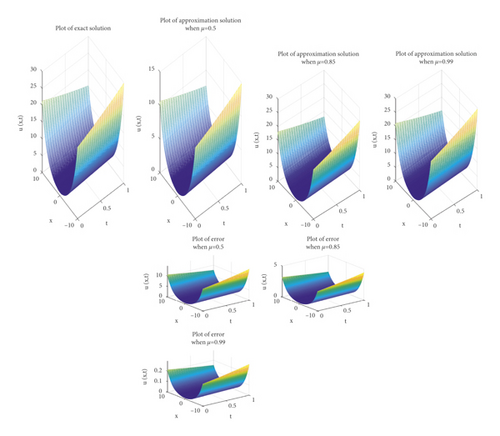
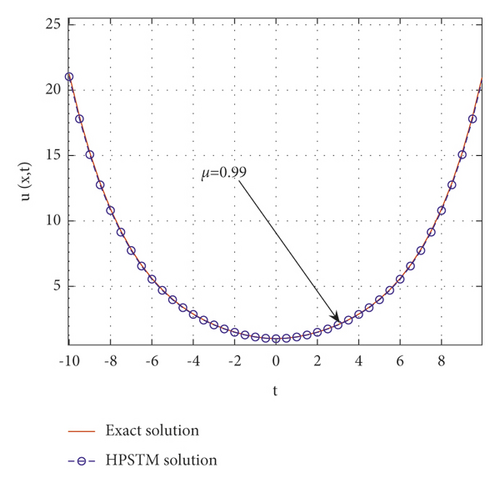
| x | |u − un| | |u − un| | ||
|---|---|---|---|---|
| μ = 0.5 | μ = 0.85 | μ = 0.99 | Method [2] | |
| 0 | 4.5709477859E − 09 | 4.5330148328E − 09 | 4.4953966746E − 09 | 1.000000000E − 09 |
| 1 | 4.4210943150E − 09 | 4.3844049537E − 09 | 4.3480200672E − 09 | 2.563406968E − 05 |
| 2 | 4.2761536328E − 09 | 4.2406670942E − 09 | 4.2054750487E − 09 | 4.601380631E − 05 |
| 3 | 4.1359646818E − 09 | 4.1016415335E − 09 | 4.0676032238E − 09 | 6.668778565E − 05 |
| 4 | 4.0003716853E − 09 | 3.9671737878E − 09 | 3.9342513912E − 09 | 9.224742588E − 05 |
| 5 | 3.8692239749E − 09 | 3.8371144396E − 09 | 3.8052713736E − 09 | 1.244701205E − 04 |
| 6 | 3.7423758233E − 09 | 3.7113189714E − 09 | 3.6805198536E − 09 | 1.615598280E − 04 |
| 7 | 3.6196862832E − 09 | 3.5896476064E − 09 | 3.5598582149E − 09 | 1.923074240E − 04 |
| 8 | 3.5010190312E − 09 | 3.4719651533E − 09 | 3.4431523893E − 09 | 1.781977647E − 04 |
| 9 | 3.3862422172E − 09 | 3.3581408576E − 09 | 3.3302727086E − 09 | 3.522674800E − 06 |
| 10 | 3.2752283194E − 09 | 3.2480482574E − 09 | 3.2210937625E − 09 | 6.615336660E − 04 |
5. Conclusion
This paper describes a numerical method based on the homotopy perturbation Sadik transform method for solving the equations such as EW, MEW, and VMEW. The fractional derivatives are used in this paper in the Caputo–Prabhakar sense. This paper demonstrates that the HPSTM is sufficient, easy, and suitable for various other nonlinear models. It can be seen that as x increases, it leads to variation in u(x, t) for waves in plasma at specific value of t. All tables and figures show that the proposed method produces numerical solutions with more accuracy. Comparison between the obtained absolute errors by the suggested method and method presented in [2] is demonstrated. Discussion on the convergence and error analysis of the proposed method is presented. Three numerical examples are given to show the applicability of the suggested method.
Conflicts of Interest
The author declares that there are no conflicts of interest.
Open Research
Data Availability
No data were used to support this study.




